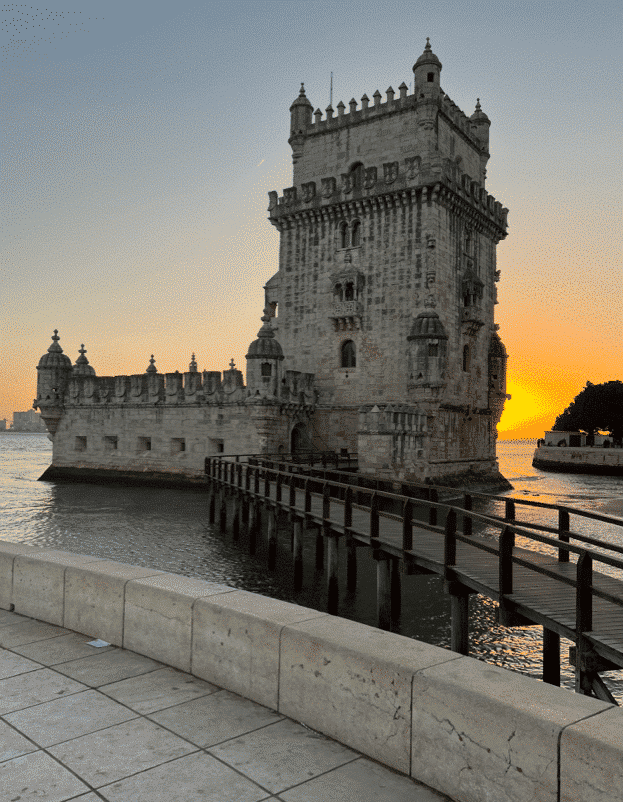Introduction to Torre de Belém
Nestled on the banks of the Tagus River in Lisbon, Portugal’s capital city, stands an iconic symbol of Portuguese maritime history – The Torre de Belém. This UNESCO World Heritage Site is a testament to Portugal’s Age of Exploration and offers visitors a glimpse into its rich past.
A Brief History of Torre de Belém
The construction of the Belem Tower began in 1514 under King Manuel I and was completed six years later in 1520. It was strategically built at the mouth of the Tagus River to guard Lisbon from seafaring invaders. During this period, known as the Age of Discoveries, Portugal was establishing itself as a global maritime power with explorers like Vasco da Gama embarking on expeditions to unknown lands.
Originally designed by military architect Francisco de Arruda, who had previously worked on fortifications in Morocco (an influence that can be seen in some Moorish-style elements), it served both as fortress and ceremonial gateway to Lisbon.
Architectural Marvels
Torre de Belém is renowned for its distinctively ornate architectural style that combines elements from Gothic and Moorish designs with hints of Italian Renaissance – a style often referred to as Manueline architecture after King Manuel I who commissioned it.
The tower consists mainly four floors: The Governor’s Room; Kings’ Room; Audience Hall; Chapel. Each floor has unique design features such as intricate stonework depicting historical scenes or symbolic motifs connected with exploration.
The exterior facade showcases beautifully carved limestone balconies, delicate turrets and ramparts which were once used for defense purposes but now offer breathtaking panoramic views over river towards Atlantic Ocean beyond.
Climbing up the Tower
Visitors are allowed to climb up the narrow spiral staircase of Torre de Belém, which leads to various floors and finally to a terrace that offers an exceptional view of Lisbon cityscape including Jerónimos Monastery, Praça do Império and Monument of Discoveries. However, please note that due to its historical structure, it might not be suitable for those with mobility issues.
The Symbolism of Torre de Belém
Beyond its architectural beauty and strategic military role, the Belem Tower carries deep symbolic significance for Portugal. It stands as a monument commemorating Portugal’s Age of Exploration during the 15th and 16th centuries when Portuguese explorers ventured into unknown territories establishing trade routes and colonies around the world.
The tower is adorned with many sculptures depicting figures from this era such as Saint Vincent – Lisbon’s patron saint holding a ship in his hands; rhinoceros – symbolizing one first animals brought back Europe by explorers; or Our Lady Safe Homecoming – protector sailors at sea.
Visiting Torre de Belém
Torre de Belém is open Tuesday through Sunday (closed on Mondays) from 10:00 AM until 5:30 PM in winter months (October-April) or until 6:30 PM during summer months (May-September). The last entry is typically half an hour before closing time. There may be long queues especially during peak tourist season so buying tickets online in advance could save you some waiting time.
This iconic landmark should definitely feature on any itinerary while visiting Lisbon. Whether you’re history enthusiast or simply enjoy stunning views over water against backdrop historic buildings – Torre Belem has something offer everyone!
Frequently asked questions
What is the Torre de Belém and why is it significant?
The Torre de Belém, or the Tower of Bethlehem, is a UNESCO World Heritage site located in Lisbon, Portugal. Built in the early 16th century during the height of the Portuguese Renaissance, it served as part of a defense system at the mouth of Tagus river and as a ceremonial gateway to Lisbon. The tower embodies Portuguese maritime discoveries and symbolizes the Age of Exploration. Its distinctive architecture incorporates both Moorish and Venetian elements making it an iconic example of Manueline style.
How can I visit Torre de Belém?
Torre de Belém is easily accessible by public transportation from central Lisbon. You can take tram 15 or bus lines 727, 28, 729, or 751 to reach there. It’s open from Tuesday to Sunday (closed on Mondays). The opening hours vary depending on season: October to April -10 am until 5:30 pm; May to September -10 am until 6:30 pm with last admission half an hour before closing time.
Are there any tickets required for visiting Torre de Belém?
Yes, you need tickets for visiting Torre De Belem but children under age of 14 have free entry. For adults ticket price varies between €4-€6 while seniors (65+) get discounted rates around €5 . There are also combined tickets available that provide access to other monuments like Jerónimos Monastery which could save cost if you plan on visiting multiple sites.
What will I see inside Torre de Belém?
The interior spaces include Governor’s Hall where King Manuel would host dignitaries; Kings Room used by royalty when they visited; Audience Room where prisoners were presented to the king; Chapel with its original 16th century altar and finally, the terrace that offers panoramic views of Lisbon and Tagus River. Also, don’t miss the rhinoceros carved into a base of one of the tower’s turrets which is said to be among Europe’s oldest images of such an animal.
What other attractions are near Torre de Belém?
Torre de Belém is located in an area rich with historical sites. Nearby you’ll find Jerónimos Monastery, another UNESCO World Heritage site known for its stunning Manueline architecture. The Monument to the Discoveries (Padrão dos Descobrimentos) celebrating Portugal’s Age of Exploration is also close by. For culinary enthusiasts, Pasteis de Belem bakery famous for Portuguese egg tart pastries should not be missed.












